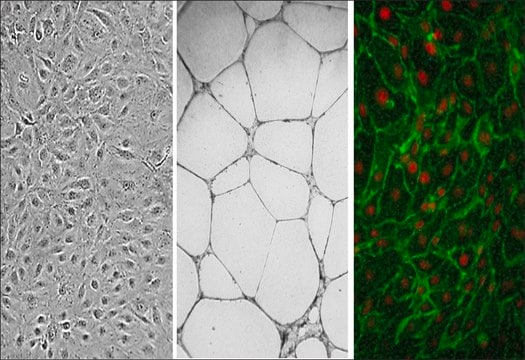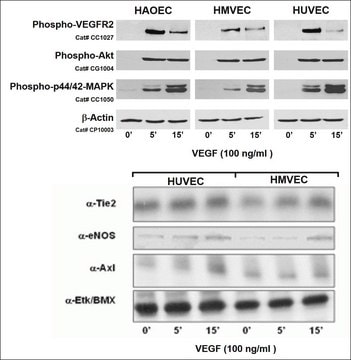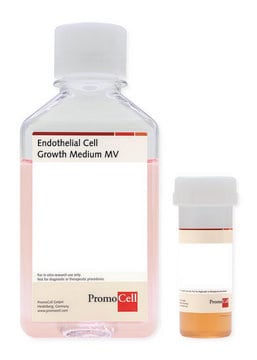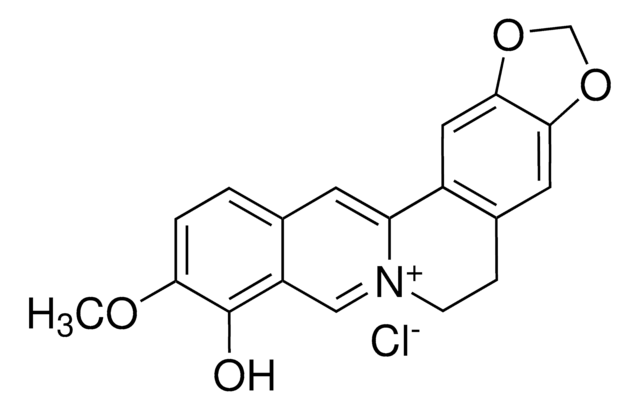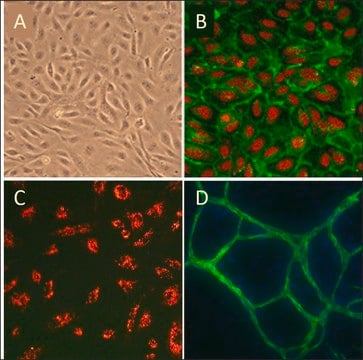S100-05A
Human Dermal Microvascular Endothelial Cells: CADMEC/HMVEC: Pre-Screened for Angiogenesis & VEGF signaling, adult
Se connecterpour consulter vos tarifs contractuels et ceux de votre entreprise/organisme
About This Item
Code UNSPSC :
41106514
Nomenclature NACRES :
NA.81
Produits recommandés
Source biologique
human blood vessels
Conditionnement
pkg of 500,000 cells
Fabricant/nom de marque
Cell Applications, Inc
Mode de croissance
Adherent
Caryotype
2n = 46
Morphologie
Endothelial
Technique(s)
cell culture | mammalian: suitable
Température de stockage
−196°C
Description générale
Lot specific orders are not able to be placed through the web. Contact your local sales rep for more details.
Endothelial cells (EC) line the blood vessels of the entire circulatory system, from aorta to capillaries, and act as a barrier between circulating blood and the rest of the vessel wall/surrounding tissues. Endothelial cells are involved in the processes of angiogenesis, vasculogenesis, vasoregulation, coagulation, fibrinolysis and selective blood barrier. They are also implicated in pathophysiological processes, including cardiovascular disease and cancer development.
The most commonly used human endothelial cells are Human Umbilical Vein Endothelial Cells, (HUVEC), Human Microvascular Endothelial Cells (HMVEC) and Human Aortic Endothelial Cells (HAOEC). Select lots of HUVEC, HMVEC, and HAOEC have been pre-screened to demonstrate stimulation-dependent angiogenesis and key endothelial cell signaling pathways (phosphorylation of VEGFR, Akt, MAPK, and expression of Tie2, eNOS, Axl and Etk/Bmx.
VEGF-Stimulated Signaling in Pre-Screened Endothelial Cells
VEGF receptor-2 (VEGFR-2) is a major VEGF of endothelial cells. VEGFR-2-mediated signaling plays a critical role in angiogenesis, including regulation of proliferation, differentiation, cell movement, and survival of endothelial cells. VEGF-induced receptor dimerization triggers activation of VEGFR-2 tyrosine kinase and autophosphorylation at a specific set of tyrosine residues, which serve as docking sites for downstream signaling components leading to activation of downstream signaling molecules, including phosphorylation of Akt and p44/42-MAPK.
Expression of Signaling Biomarkers in Pre-Screened Endothelial Cells
Prescreened Endothelial Cells express the following important biomarkers:
Endothelial cells (EC) line the blood vessels of the entire circulatory system, from aorta to capillaries, and act as a barrier between circulating blood and the rest of the vessel wall/surrounding tissues. Endothelial cells are involved in the processes of angiogenesis, vasculogenesis, vasoregulation, coagulation, fibrinolysis and selective blood barrier. They are also implicated in pathophysiological processes, including cardiovascular disease and cancer development.
The most commonly used human endothelial cells are Human Umbilical Vein Endothelial Cells, (HUVEC), Human Microvascular Endothelial Cells (HMVEC) and Human Aortic Endothelial Cells (HAOEC). Select lots of HUVEC, HMVEC, and HAOEC have been pre-screened to demonstrate stimulation-dependent angiogenesis and key endothelial cell signaling pathways (phosphorylation of VEGFR, Akt, MAPK, and expression of Tie2, eNOS, Axl and Etk/Bmx.
VEGF-Stimulated Signaling in Pre-Screened Endothelial Cells
VEGF receptor-2 (VEGFR-2) is a major VEGF of endothelial cells. VEGFR-2-mediated signaling plays a critical role in angiogenesis, including regulation of proliferation, differentiation, cell movement, and survival of endothelial cells. VEGF-induced receptor dimerization triggers activation of VEGFR-2 tyrosine kinase and autophosphorylation at a specific set of tyrosine residues, which serve as docking sites for downstream signaling components leading to activation of downstream signaling molecules, including phosphorylation of Akt and p44/42-MAPK.
Expression of Signaling Biomarkers in Pre-Screened Endothelial Cells
Prescreened Endothelial Cells express the following important biomarkers:
- Tie2, a receptor tyrosine kinase critical for the angiogenic remodeling, sprout formation, survival of endothelial cells and vessel stabilization processes;
- eNOS (endothelial Nitric Oxide Synthase), the enzyme that producse NO which is an important signaling molecule that regulates a diverse range of physiological events and is required for normal endothelial function;
- Axl, a receptor tyrosine kinase whose ligand is the survival factor Gas6 (growth arrest-specific gene 6 product) implicated in many processes, such as cell survival, leukocyte transmigration and neointima formation.
- Etk/Bmx (Endothelial/epithelial Tyrosine Kinase), a member of the Btk family, participates in signal transduction stimulated by growth factor receptors, cytokine receptors, G-protein-coupled receptors, antigen receptors, and integrins, and has been implicated in cell adhesion, migration, proliferation, and survival.
Origine de la lignée cellulaire
Blood Vessels
Application
Endothelial vessel function, cell signaling, angiogenesis
Composants
Cell Basal Medium containing 10% FBS & 10% DMSO
Notes préparatoires
- 2nd passage, >500,000 cells in Cell Basal Medium containing 10% FBS & 10% DMSO
- Can be cultured at least 16 doublings
Procédure de repiquage
Please refer to the CADMEC/HMVEC Culture Protocol.
Clause de non-responsabilité
Ce produit, destiné à la recherche scientifique, est soumis à une réglementation spécifique en France, y compris pour les activités d'importation et d'exportation (Article L 1211-1 alinéa 2 du Code de la Santé Publique). L'acheteur (c'est-à-dire l'utilisateur final) est tenu d'obtenir une autorisation d'importation auprès du Ministère français de la Recherche, mentionné à l'article L1245-5-1 II du Code de la Santé Publique. En commandant ce produit, vous confirmez détenir l'autorisation d'importation requise.
Code de la classe de stockage
11 - Combustible Solids
Classe de danger pour l'eau (WGK)
WGK 3
Point d'éclair (°F)
Not applicable
Point d'éclair (°C)
Not applicable
Certificats d'analyse (COA)
Recherchez un Certificats d'analyse (COA) en saisissant le numéro de lot du produit. Les numéros de lot figurent sur l'étiquette du produit après les mots "Lot" ou "Batch".
Déjà en possession de ce produit ?
Retrouvez la documentation relative aux produits que vous avez récemment achetés dans la Bibliothèque de documents.
Les clients ont également consulté
Notre équipe de scientifiques dispose d'une expérience dans tous les secteurs de la recherche, notamment en sciences de la vie, science des matériaux, synthèse chimique, chromatographie, analyse et dans de nombreux autres domaines..
Contacter notre Service technique